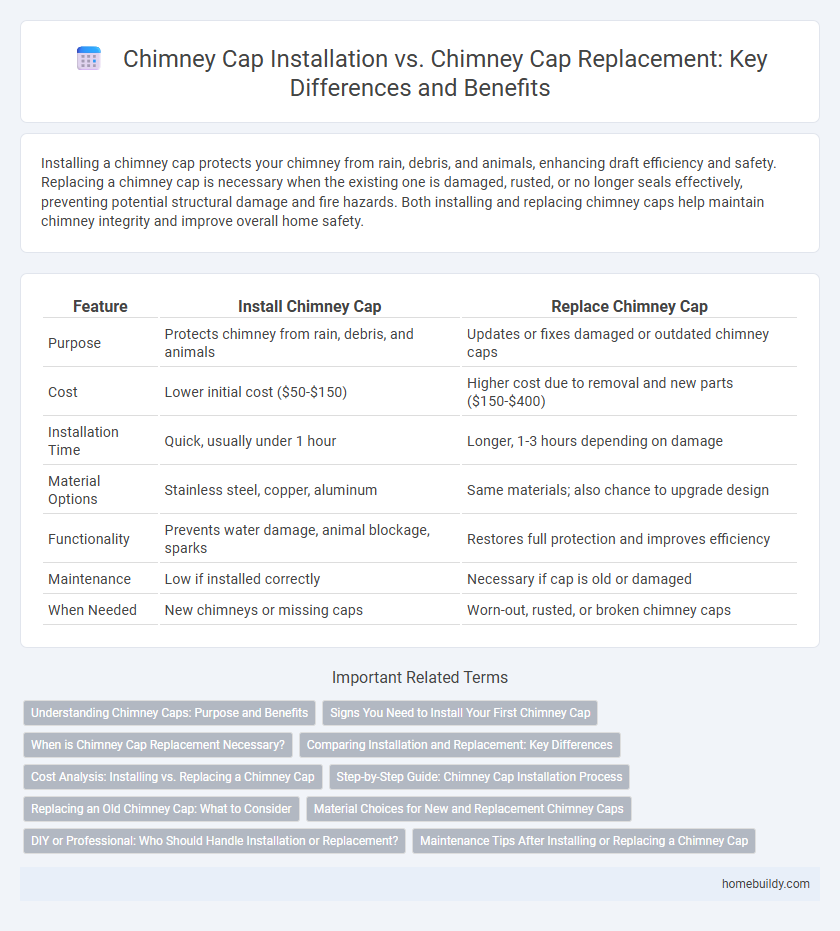Installing a chimney cap protects your chimney from rain, debris, and animals, enhancing draft efficiency and safety. Replacing a chimney cap is necessary when the existing one is damaged, rusted, or no longer seals effectively, preventing potential structural damage and fire hazards. Both installing and replacing chimney caps help maintain chimney integrity and improve overall home safety.
Table of Comparison
| Feature | Install Chimney Cap | Replace Chimney Cap |
|---|---|---|
| Purpose | Protects chimney from rain, debris, and animals | Updates or fixes damaged or outdated chimney caps |
| Cost | Lower initial cost ($50-$150) | Higher cost due to removal and new parts ($150-$400) |
| Installation Time | Quick, usually under 1 hour | Longer, 1-3 hours depending on damage |
| Material Options | Stainless steel, copper, aluminum | Same materials; also chance to upgrade design |
| Functionality | Prevents water damage, animal blockage, sparks | Restores full protection and improves efficiency |
| Maintenance | Low if installed correctly | Necessary if cap is old or damaged |
| When Needed | New chimneys or missing caps | Worn-out, rusted, or broken chimney caps |
Understanding Chimney Caps: Purpose and Benefits
Installing a chimney cap prevents debris, animals, and water from entering the chimney, preserving its structural integrity and enhancing safety. Replacing an existing chimney cap is essential when corrosion, damage, or wear compromises its effectiveness, ensuring continued protection and proper ventilation. Both installation and replacement contribute to improved chimney performance, reduced maintenance costs, and increased home safety.
Signs You Need to Install Your First Chimney Cap
Signs you need to install your first chimney cap include frequent water leaks in the chimney, evidence of animal nests or debris blocking the flue, and visible rust or deterioration on the chimney crown. A properly installed chimney cap prevents rain, debris, and pests from entering the chimney, reducing fire hazards and structural damage. If no cap exists, installation is essential to improve safety, enhance draft efficiency, and prolong the chimney's lifespan.
When is Chimney Cap Replacement Necessary?
Chimney cap replacement becomes necessary when the existing cap shows signs of severe rust, corrosion, or physical damage that compromises its ability to keep out rain, debris, and pests. Installing a new chimney cap is preferable if the current one is missing or never installed, whereas replacement is recommended when deterioration affects the structural integrity and safety of the chimney. Regular inspection every few years helps determine whether repair or full replacement is needed to maintain optimal chimney function.
Comparing Installation and Replacement: Key Differences
Installing a chimney cap involves fitting a new protective cover on an uncapped chimney, which prevents debris, animals, and water from entering the flue, whereas replacing a chimney cap entails removing a damaged or outdated cap and installing a new one to restore its functionality. Installation typically requires selecting the right size and material for an existing chimney, while replacement demands careful removal to avoid damaging the chimney structure and ensuring a proper fit with updated components. Both processes improve chimney safety and efficiency, but replacement is often more complex due to addressing wear, corrosion, or structural issues in the existing cap.
Cost Analysis: Installing vs. Replacing a Chimney Cap
Installing a new chimney cap typically ranges from $150 to $400, depending on materials and labor, while replacing an existing cap can cost between $300 and $700 due to removal and potential repairs. Installation is more cost-effective when no prior damage or corrosion exists, whereas replacement is necessary if the cap is rusted, cracked, or structurally compromised. Choosing installation versus replacement impacts long-term maintenance costs and chimney efficiency, making a detailed cost analysis essential for informed decision-making.
Step-by-Step Guide: Chimney Cap Installation Process
Install chimney cap by first measuring the chimney crown for a precise fit to ensure proper coverage and protection against water and debris. Remove the old cap completely before aligning the new chimney cap, securing it with screws or a strong adhesive suitable for metal surfaces. Seal edges with high-temperature silicone caulk to prevent leaks and inspect the final installation for stability and proper airflow.
Replacing an Old Chimney Cap: What to Consider
Replacing an old chimney cap requires assessing the current cap's condition, including rust, cracks, and fit to ensure proper protection against rain, debris, and animals. Select a durable material like stainless steel or copper to maximize longevity and prevent corrosion. Proper sizing and secure installation maintain draft efficiency and prevent sparks from escaping, which are crucial for chimney safety and performance.
Material Choices for New and Replacement Chimney Caps
Choosing the right material for installing or replacing a chimney cap significantly impacts its durability and performance. Stainless steel offers excellent corrosion resistance and longevity, making it ideal for harsh weather conditions, while copper provides a traditional aesthetic with natural patina but requires more maintenance. Aluminum caps are lightweight and cost-effective, suitable for moderate climates, but may not withstand extreme conditions as well as other materials.
DIY or Professional: Who Should Handle Installation or Replacement?
DIY installation of a chimney cap is possible for those with basic tools and knowledge, but it requires careful measurement and secure fastening to prevent leaks and animal entry. Professional chimney cap replacement ensures proper fit, adherence to local building codes, and safe handling of potential chimney hazards like creosote buildup. Homeowners uncertain about chimney structure or safety should opt for experts to avoid costly mistakes and ensure long-term protection.
Maintenance Tips After Installing or Replacing a Chimney Cap
Regular inspection and cleaning are essential maintenance tips after installing or replacing a chimney cap to prevent blockages caused by debris or creosote buildup. Ensure the chimney cap is securely fastened and check for signs of rust or damage to maintain its effectiveness against rain, animals, and downdrafts. Scheduling annual professional chimney inspections helps identify potential issues early, prolonging the life of the chimney cap and enhancing overall fireplace safety.
Install chimney cap vs Replace chimney cap Infographic

 homebuildy.com
homebuildy.com